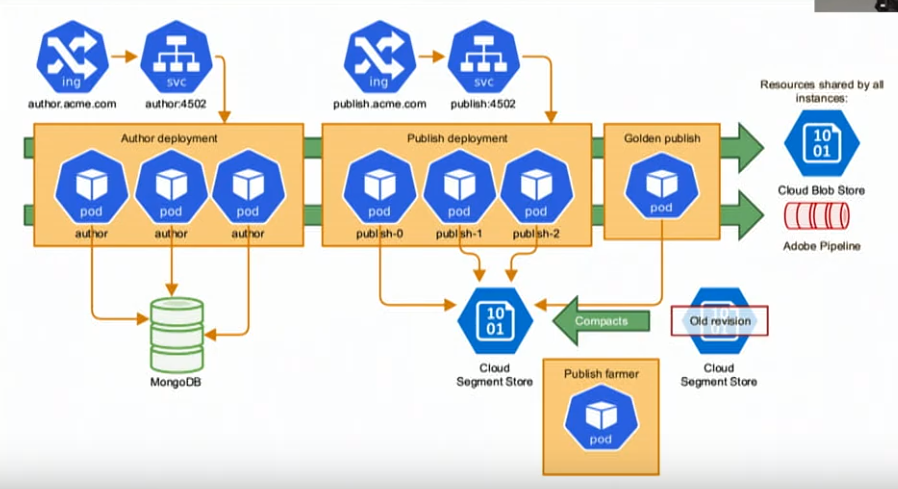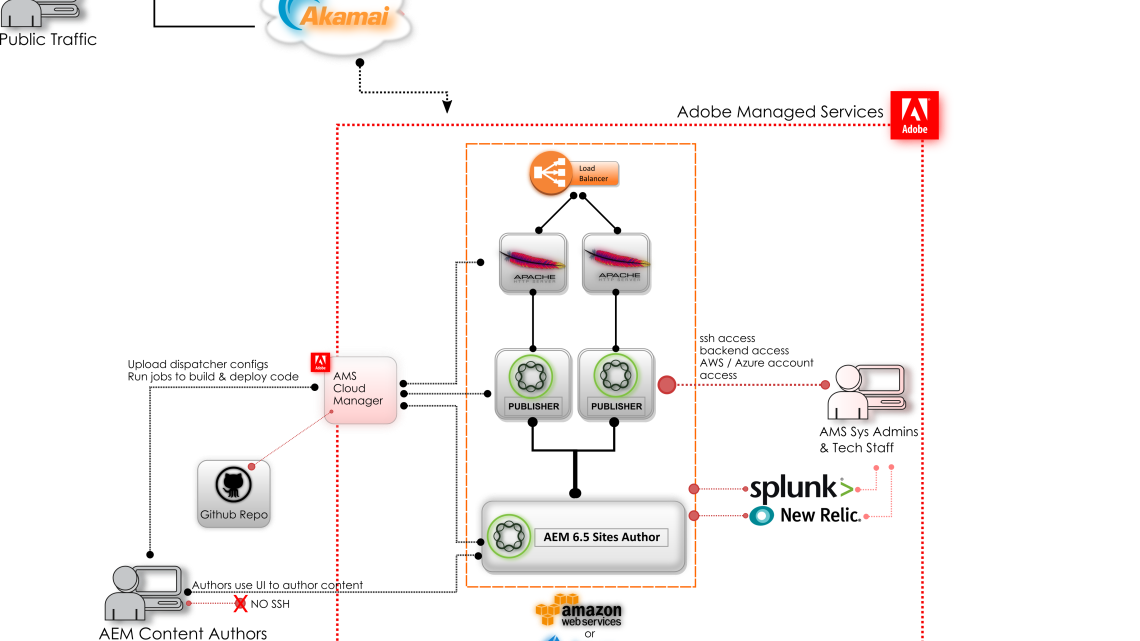Introduction
Adobe Experience Manager (AEM) is a powerful content management system developed by Adobe, designed to create, manage, and deliver exceptional digital experiences across various channels. One crucial aspect of AEM is its deployment options, which allow organizations to choose the most suitable environment for their specific needs. In this article, we will explore the different deployment options available for AEM and delve into the key considerations, features, and benefits associated with each option.
AEM Deployment Options Explained
Cloud Deployment
AEM provides the flexibility of deploying your instances in a cloud environment, leveraging the infrastructure and services offered by cloud service providers like Amazon Web Services (AWS) or Microsoft Azure. There are different approaches to cloud deployment:
- Infrastructure as a Service (IaaS) Approach: With IaaS, you can deploy AEM on virtual machines provided by the cloud service provider. This approach offers scalability, as you can easily adjust the computing resources based on demand. Additionally, it allows customization options to tailor the infrastructure to your specific requirements.
- Platform as a Service (PaaS) Approach: In this approach, AEM is deployed on a platform provided by the cloud service provider. The platform abstracts away the infrastructure management, allowing you to focus more on building and managing your digital experiences. A notable example of this approach is “AEM as a Cloud Service,” where Adobe manages the infrastructure and provides a scalable, managed environment for AEM deployment.

On-premises Deployment
For organizations that prefer to have full control over their infrastructure, AEM supports on-premises deployment. This option involves hosting AEM instances within an organization’s own data centers or private cloud environment. Some key considerations for on-premises deployment include:
- Hardware and Software Requirements: On-premises deployment requires appropriate hardware resources, such as servers and storage, to support the AEM infrastructure. It also involves the installation of the necessary software components, including operating systems, databases, and web servers.
- Installation Process and Customization Options: On-premises deployment typically involves a manual installation process, where you install and configure AEM on the designated infrastructure. This option provides extensive customization capabilities, allowing you to tailor the deployment to your specific needs.
- Maintenance and Control Considerations: With on-premises deployment, you have full control over the maintenance and updates of your AEM instances. This includes applying patches, security updates, and performance optimizations based on your organization’s requirements.

Hybrid Deployment
A hybrid deployment model combines the benefits of both cloud and on-premises environments. This approach offers flexibility, allowing organizations to optimize their resources based on specific use cases. Key aspects of hybrid deployment include:
- Combining Cloud and On-premises Environments: In a hybrid model, you can deploy some components of your AEM infrastructure in the cloud while keeping others on-premises. This allows you to utilize the scalability and managed services offered by the cloud, while maintaining control over sensitive data or custom infrastructure requirements.
- Challenges and Considerations for Integration: Integrating cloud and on-premises environments requires careful planning and consideration. Data synchronization, identity management, and network connectivity are essential factors to ensure seamless integration between the two environments.
- Ensuring Data Synchronization and Load Balancing: With a hybrid deployment, it’s crucial to establish mechanisms for synchronizing data between cloud and on-premises instances of AEM. Load balancing strategies should also be implemented to distribute traffic efficiently across the hybrid environment.
Key Considerations in AEM Deployment
Scalability
Scalability is a crucial aspect of AEM deployment, allowing organizations to handle increased workloads and adapt to changing demands. Here are some key considerations for achieving scalability in AEM:
- Horizontal and Vertical Scaling Options: AEM supports both horizontal and vertical scaling. Horizontal scaling involves adding more instances to distribute the workload, while vertical scaling involves increasing the resources of individual instances. The choice depends on factors such as traffic patterns, resource availability, and budget constraints.
- Leveraging Caching Mechanisms for Improved Performance: Implementing caching mechanisms in AEM can significantly enhance performance and scalability. Caching static or less frequently changing content reduces the load on the AEM infrastructure and improves response times for end-users.
- Designing a Distributed Architecture for Scalability: AEM allows the deployment of multiple instances across different geographical locations. This distributed architecture enables organizations to scale globally, serving users from various regions while reducing latency and improving availability.
Reliability
To provide a seamless digital experience, AEM must ensure high reliability, minimizing downtime and performance issues. Here are key considerations for achieving reliability in AEM deployment:
- Importance of High Availability in AEM Deployment: High availability ensures that AEM instances are accessible even in the event of hardware failures or software issues. Deploying redundant AEM instances and implementing failover mechanisms ensures uninterrupted service and minimizes disruptions.
- Failover Mechanisms and Disaster Recovery Strategies: AEM deployment should incorporate failover mechanisms to automatically switch to backup instances in case of failure. Additionally, having a robust disaster recovery strategy ensures data protection and enables quick recovery in the face of catastrophic events.
- Monitoring and Error Handling for Proactive Maintenance: Implementing effective monitoring tools and error handling mechanisms allows administrators to identify and address issues before they impact end-users. Proactive maintenance, including regular health checks, performance monitoring, and log analysis, ensures optimal AEM operation.
Security
Securing AEM instances is vital to protect against unauthorized access, data breaches, and vulnerabilities. Here are key considerations for ensuring security in AEM deployment:
- Ensuring Secure Access to AEM Instances: AEM provides various authentication mechanisms, including username/password, LDAP integration, and single sign-on (SSO) solutions. By enforcing strong authentication, organizations can ensure that only authorized users can access the AEM environment.
- Authentication and Authorization Mechanisms: AEM offers robust authentication and authorization capabilities, allowing fine-grained control over user access and permissions. Role-Based Access Control (RBAC) enables organizations to assign specific roles to users, ensuring appropriate access levels based on responsibilities.
- Encryption: Protecting sensitive data is crucial in AEM deployment. Encrypting data at rest and in transit using industry-standard encryption protocols adds an extra layer of security, ensuring data confidentiality and integrity.
Integration Capabilities
AEM’s integration capabilities are vital for organizations to connect with other systems and tools seamlessly. Here are key considerations for integration in AEM deployment:
- APIs and Web Services for Seamless Integration: AEM provides a comprehensive set of APIs and web services that enable integration with external systems. These APIs allow organizations to exchange data, trigger workflows, and automate processes between AEM and other applications or services.
- Content Repository Integration for Data Consistency: AEM integrates with various content repositories, enabling organizations to leverage existing content assets and ensure data consistency across systems. Integration with external repositories also allows centralized management of assets and content.
- CRM and Marketing Automation Integration for Personalized Experiences: AEM’s integration with Customer Relationship Management (CRM) systems and marketing automation platforms enables organizations to deliver personalized experiences to their customers. Integration with CRM systems facilitates targeted marketing campaigns, while marketing automation integration enables personalized content recommendations and lead nurturing.
Supporting Features in AEM Deployment
Version Control
Version control is essential in managing content and code changes within AEM. Here are key aspects of version control in AEM deployment:
- Managing Content and Code Changes: AEM provides versioning capabilities, allowing users to track and manage changes made to content and code assets. This enables collaboration, rollbacks, and auditing of changes.
- Versioning, Branching, and Merging: AEM allows users to create different versions of content and code, facilitating parallel development and experimentation. Branching and merging mechanisms enable teams to work on separate branches and merge changes when ready.
- Rollback and Conflict Resolution Mechanisms: In case of errors or issues, AEM provides rollback capabilities to revert to previous versions of content or code. Conflict resolution mechanisms help in managing conflicts that may arise when multiple users are working on the same assets simultaneously.
Deployment Automation
Automation plays a crucial role in streamlining the deployment process of AEM instances. Here are key aspects of deployment automation in AEM:
- Introduction to CI/CD and DevOps Practices: AEM deployment can benefit from Continuous Integration/Continuous Deployment (CI/CD) practices and DevOps principles. CI/CD pipelines automate the build, testing, and deployment of AEM instances, reducing manual effort and ensuring consistent, error-free deployments.
- Building Deployment Pipelines for Efficient Releases: AEM deployment pipelines encompass various stages, including code compilation, testing, packaging, and deployment. By creating automated deployment pipelines, organizations can ensure reliable and repeatable deployments, with the ability to roll back changes if necessary.
- Configuration Management and Continuous Improvement: AEM deployment automation should include configuration management practices to manage environment-specific configurations and ensure consistency across deployments. Continuous improvement processes, such as monitoring, feedback loops, and iterative enhancements, help optimize the deployment process over time.
Conclusion
In conclusion, choosing the right AEM deployment option is crucial for organizations aiming to deliver exceptional digital experiences. Whether you opt for cloud deployment, on-premises deployment, or a hybrid model, understanding the key considerations, features, and benefits of each option allows you to make an informed decision. Scalability, reliability, security, integration capabilities, version control, and deployment automation are essential aspects to consider when deploying AEM. By leveraging the appropriate deployment option and supporting features, organizations can unleash the full potential of AEM and provide engaging digital experiences to their users.

I’m Kirill Efimov, an experienced AEM developer with over 10 years of experience in Java and web development. I’m skilled in developing AEM components, templates, workflows, and integrations with other systems, and I’m passionate about delivering high-quality solutions to my clients.
I also believe in knowledge-sharing and staying up-to-date with the latest developments in the industry. Through blog posts, tutorials, and speaking engagements, I’m committed to contributing to the AEM community and helping others overcome the challenges they may face in their AEM projects.